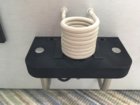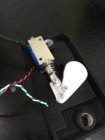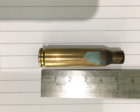I thought I would post a couple of pics of my shelf setup. It has been printed using SLS 3D printing technology. I used the same print service that I used for the autofeeder parts. A slightly amended version is currently being printed using the more advanced HP Jet Fusion 4200 printer and it's very innovative technology.
(Click on the thumbnail to view a larger version.)

It is 15mm thick and the OPB819Z IR switch is embedded in the shelf with the wires passing through holes to the bottom. The main reason to embed the IR switch (it is just push fit) is to not lose the height adjustment (about 8mm) for a smaller case such as .223 Rem. Now the shelf can be moved closer to the bottom of the coil.
Here's a couple of shots of the solenoid setup. The solenoid is simply attached via some rather strong double-sided padded tape I have. It can, with a little effort, be removed and refitted. The trap door shown here is a prototype fashioned by hand from an HDPE chopping board. (Don't tell my wife.) I've also designed a version in 3D software and it is being printed alongside the modified shelf. A tap hole for M2 thread is placed on the underside of the shelf as part of the printed design to be used as the hinge point for the trap door paddle. The link was fashioned by hand out of 1mm aluminium. It is rigidly fixed to the solenoid shaft. Play in the socket where it attaches to the trap door paddle prevents binding. The flat on flat surfaces prevent the solenoid pull rod from rotating.


The shelf rides on rails which are merely these cabinet door handles cut to length. I think I purchased the 4" wire pull version (and they cost about $4 for 2). (I note they are currently out of stock but I am sure that is a temporary situation.) An M4 set screw at either end of the shelf holds them in place. Here I very much borrowed from the tidy design of
@dabeechman (post 818 on pg 41). Thank you dabeechman.
https://www.ebay.com/itm/Cabinet-Pull-Drawer-Handle-Knob-Satin-Nickel-Swiss-Kelly-Kitchen-Hardware/323038148019?ssPageName=STRK:MEBIDX:IT&_trksid=p2060353.m2749.l2649
http://swisskelly.com/categories/wire-pulls.html
The slightly amended version of the shelf I am having printed corrects the diameter of the holes for the rails (you can see in the pics that I reamed these out 0.5mm) and their placement***, and also increases the drop hole to accommodate 338 Lapua. When I was doing these revisions
@BillK55 convinced me to design an insert which would help ensure that a smaller case such as the .223 Rem would drop into the centre of the hole. The insert is merely placed in the hole and aligned so as to not block the IR beam of the switch. It reduces the hole from 15.5mm in diameter to 11.5mm (versus the 9.6mm width of a .223 case). The 55 degree chamfer of the hole mouth is maintained.

The parts are fantastic quality. A print run of 2 shelves, 2 inserts and 2 trap door paddles costs about $65 (including $5 for delivery). So in the grand scheme of things it is quite economical for a professionally manufactured product and saves a tremendous amount of hassle figuring out this part of the build. All I have to do is thread the M4 tap holes and the M2 hole for the trap door hinge and the shelf is done.
If anyone is interested in following a similar setup just send me a PM.
*** I have two of the first version, reamed and threaded which I can sell. They work just fine if the rails are spaced off the front of the enclosure by 3mm - the amount of material I placed behind the IR switch. I merely forgot to adjust the hole placement. They have a 14.5mm drop hole and so not big enough for 338 Lapua and, as a result, the insert mentioned won't work with these. Other than that they're rather awesome.


























